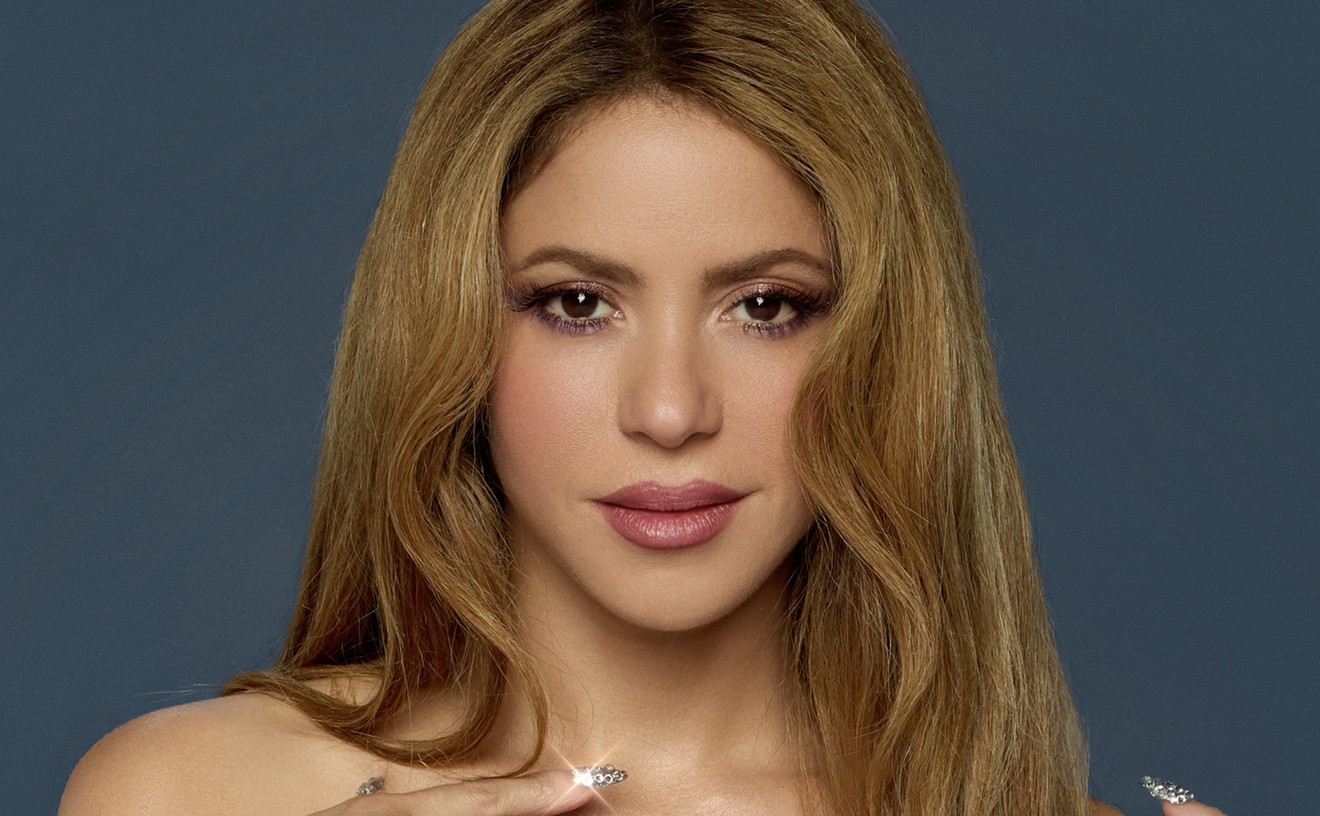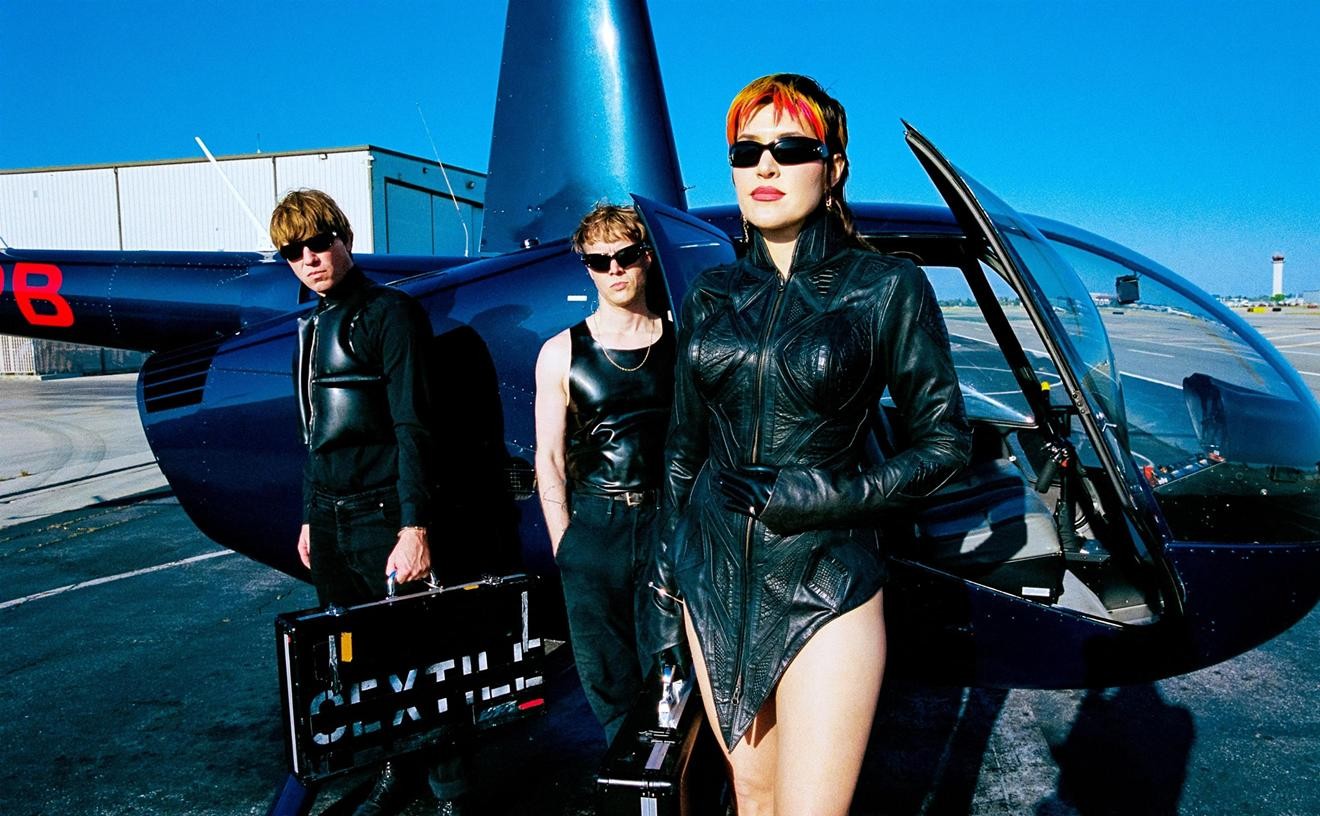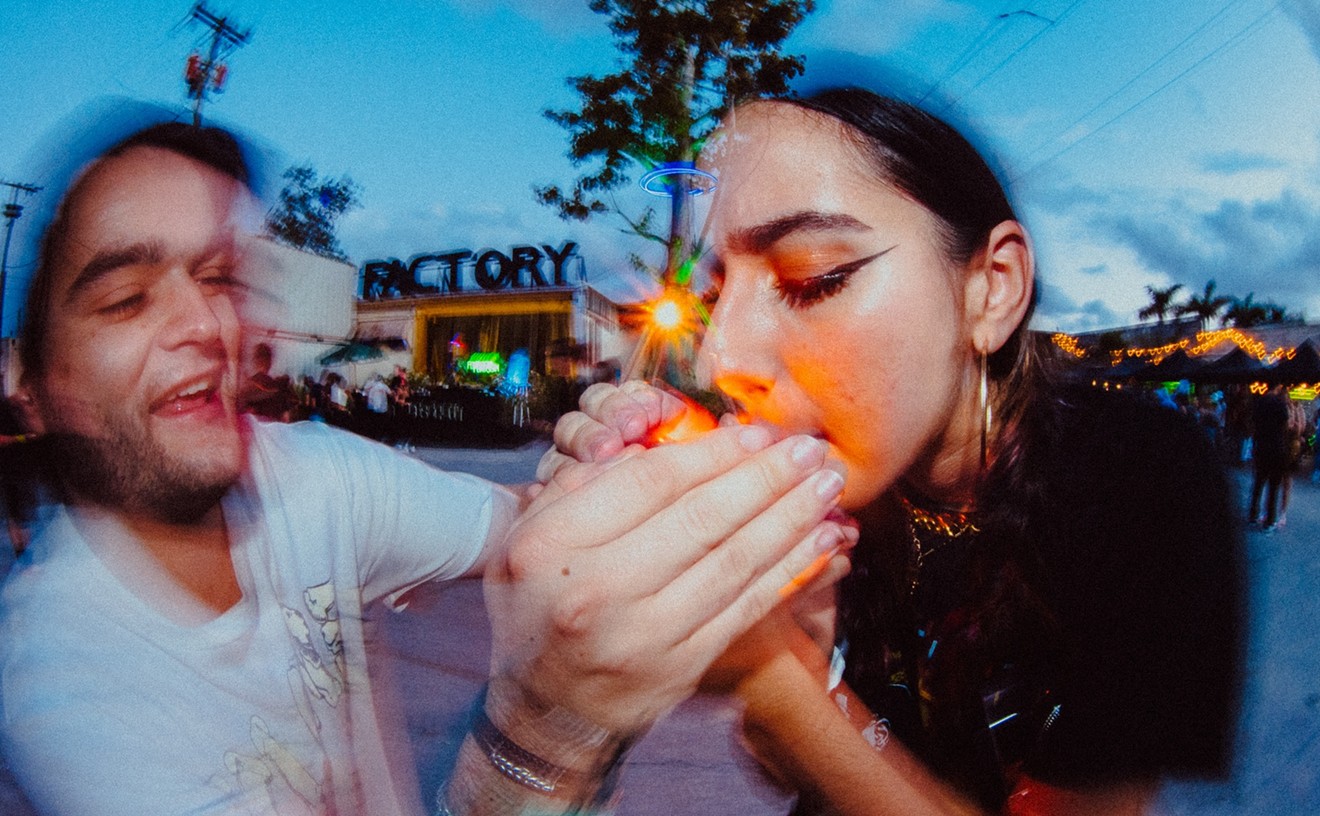As might also have been anticipated, when the festival jumped the Intracoastal to Bayfront Park and began pulling larger audiences and an ever more prestigious lineup of DJs and electronic music acts, an equally vocal fan base sprang up from the area's growing cadre of loosely aligned club kids, nightlife promoters, spare room mixtape makers, circuit-party aficionados, and Ecstasy geeks. In Miami's strict caste system of nightlife and clubs, the outdoor dance party was egalitarian and democratic. Electronic music had an androgynous, intellectual appeal beyond the booty shakers, and the crowds -- dressed in baggy, comfortable, unisex cargo pants and T-shirts -- charged the early festivals with love and energy not necessarily of a sexualized sort.
Yet despite the predictable differences of opinion, Ultra has grown into a wonderfully successful all-day multistage concert, and one that -- in the face of last year's shocking failure of the briefly revived Lollapalooza and underwhelming Curiosa tours -- could arguably be called artistically and commercially unique. On Saturday, March 26, when the nearly 15,000 people expected stream into the park through the Biscayne Boulevard-side chutes and ticket booths into Ultra 7, a mini-village will have been erected to reflect a Potemkin-like temporary idyll of utopia. Chances are the illusion (or, for some, hallucination) will hold.
The indisputable big-name headliner this year is Moby, whose music, through incessant licensing for car commercials, soft drinks, and extreme sports events, is as familiar to dads in Barcaloungers as it is to teens with iPods. But there are other, more credible, acts as well, including composer-keyboardist-DJ BT, the inventive multimedia performer Sander Kleinenberg, funk-tinged Timo Maas, and inevitable sets by the ubiquitous Tisto, Paul Oakenfold, Paul Van Dyk, and Ferry Corsten. Underworld, an underground cult draw for years since they were first known as Freur, won't be bringing their brooding samples and crisp designs around this season, so wild card hopes are pinned to local favorites Danny Tenaglia, Carl Cox (he of the three-hour sets legendary for their exhaustive tranciness), and Erick Morillo, who is popular for his Subliminal Sessions mix CD collections.
One of Ultra's newcomers, the Australian three-piece Infusion, plans to play a progressive house set with real instruments instead of turntables or laptop computers. Infusion sounds like Gary Numan with better production, a little like Interpol, a little like late-Nineties New Order. "We tend to have a rough, rock-and-roll mentality," says Infusion's Jamie Stevens. "We don't use software when we play live, so it's all very hands on."
Stevens says the group achieves tech resonance by loading all of its samples into a 28-channel mixer and then using those sounds spontaneously during each performance. Stevens says he expects crowds at Ultra "to have fun, jump around, and enjoy themselves."
That, generally, is the idea at the thirteen-hour show, an idea the City of Miami, after several balks and a couple of threats, seems now to wholeheartedly support and abet. Two years ago, citing concerns about drug use at the concert, Miami Mayor Manny Diaz threatened to pull the plug on Ultra.
City spokeswoman Kelly Penton, however, clucks with disapproval over the bad old days. "If you look at some of the things that were going on in the park, in terms of vendor sales and things the promoters allowed, let's face it, those things were associated with drug use -- the water, the lollipops, the tables where you could get a massage," Penton recalls. Most egregious, she says, was the "outrageous price for a bottle of water."
As is the case at most Miami-area nightclubs, bottled water at Ultra is pricey -- about six dollars a pop. But the city laid down the law about the beverage, issuing an entire multi-page document about how, where, and for how much money water may be sold. This, among other things, seems to have smoothed relations between Ultra and the City of Miami, despite the fact that in 2004, according to a story in the Miami Herald, there were 117 drug-related arrests at the festival, and more than $25,000 worth of Ecstasy, crystal meth, and marijuana was confiscated. (Ultra festivalgoers are not allowed to bring anything, including purses, picnic baskets, thermoses, or backpacks, into the concert.)
Thus, says Tim Schmand, executive director of the Bayfront Park Management Trust, it becomes incumbent upon the Ultra environment to provide something along the lines of a commissary, a way for "people to purchase or get anything they'd want from the outside." The Trust staff is charged with the nuts and bolts of getting ready for, monitoring, and cleaning up after the festival.
Of course the concert also generates revenue for the park. Schmand explains how this works: "The promoter controls their own vending, but, as a rental space, we get paid our fees, which were $217,000 [in 2004] from the promoters. This includes use of the park, loading dates, administration, police and fire department overtime, and off-duty officer compensation, solid waste, a private security company, ticket counters, and clean-up."
Despite the logistical challenges created by thousands of potentially hungry, thirsty, sunburned, or rained-on concertgoers; multiple stages; and tons of circuitry, Schmand is totally enamored of Ultra.
"We do 70 events throughout the year, including some other large music festivals, and there is nothing that comes close to Ultra," says Schmand. He compares Ultra to Woodstock, "and I mean the good, original Woodstock."
Ultra Music Festival's creators head a media mini-empire. Russell Faibisch was already a successful businessman, running an insurance and bail bonds company, before founding Ultra in 1998. Partner Alex Omes, the music director at crobar, is a veteran club manager, and has occasionally published D'VOX magazine since 1997. (The most recent issue came out this past year, and he says he plans to put out another issue in the near future.)
Faibisch says his interest in the dance -music world blossomed organically, from his days as a fan of industrial music and acts such as Nine Inch Nails, Nitzer Ebb, and Front 242. "I've always been a fan of electronic music, since its existence," he says. But when he speaks of the growth and success of the festival, he speaks as the co-founder and primary force behind Ultra, Inc.
"Aside from Ultra becoming one of the top music festivals of its kind in the entire world, it has become a dance-related youth culture lifestyle," Faibisch proclaims, adding some notable notches in the festival's biography: "Some current projects include UMF6 being released on DVD nationwide. It was captured in high definition last year and broadcast to more than 55 million homes on pay-per-view systems across the U.S. for 45 days. The [Ultra Music Festival 01] compilation is being released nationwide March 22 on Ultra Records, and we are about to launch Ultra worldwide. We will be taking the festival to New York City in the late summer or early fall this year, as well as doing some club nights throughout the country and in Ibiza."
In 2003, however, when Ultra tried to present a second Labor Day festival on Miami Beach near 21st Street and Collins Avenue, the City of Miami Beach turned down its permit request, citing the many arrests Ultra often generates as a key issue. Faibisch and Omes managed to negotiate a last-minute location change to the Miami Beach Convention Center, but the resulting August 31 event was, by most accounts, a disaster, drawing only a few hundred people.
Faibisch, though, usually has a positive spin on Ultra's past woes. "There are a high number of drug-related arrests because of the direct action we take as an organization to enforce our zero-tolerance drug policy," he says. And of the occasional lawsuit filed by a vendor claiming to have gone unpaid (complaints in the "contract and indebtedness" category are filed with Miami-Dade County's Civil Court Clerk on behalf of Omnistage and Concert Solutions Inc.), all Faibisch will say is: "In any business there are going to be financial disputes. Some are valid, but most aren't."
Other dustups have blown up -- and out -- on the street. Earlier this year, Louis Puig, owner of Space, downtown Miami's cavernous superclub, seemingly spontaneously picked a fight with Ultra. (Space and Ultra have a connection via Omes, who was once the music director at Puig's place before moving to crobar.) In November, Puig sent out a series of widely circulated e-mails claiming that he would start his own rival festival, Spacefest, and steal away Paul Van Dyk, Tisto, and other top DJs with exclusive contracts, which would prevent them from playing at Ultra. But Spacefest never came to fruition. (Puig could not be reached for comment.)
Faibisch is gracious about the controversy -- to a point. "There is no rivalry between Space and Ultra. We are a music festival. They are a nightclub. There is really nothing more to it than that," he says, adding, "As you see, there is only one music festival occurring during WMC."
"Louis, he's a very knowledgeable club owner," sighs Omes, a friendly, fast-talking fellow. "But he knows nightclubs, and we know festivals. Running a club is hard enough, believe me, and I'm one of the best in the business; it's taken me ten years to get to the level I'm at. But putting on a festival like Ultra is another thing altogether."
New to Ultra this year is a huge after party/concert at American Airlines Arena featuring headliners Sasha and John Digweed and rising star Hernan Cattaneo. Last year it signed a co-sponsorship deal with Winter Music Conference, making it the official closing party of conference week. And the organizers continue to bring in influential financial backers such as Andrew Fox owner of clubplanet.com and a concert ticketing business, wantickets.com.
"We funded Ultra, we ticket Ultra through our ticketing company wantickets.com, and ... we are the production company handling all the logistics of the festival," Fox says. "Ultra needed our help on production and rather than having them bring in outside investors we decided to fund it and keep control of the money."
The machinations of industry, however, will probably be the last thing on the minds of the throngs who turn up for a noon-to-midnight marathon of DJs and dancing set in the incredible natural amphitheater of Miami's beautiful Bayfront Park, Ultra's undeniably breathtaking setting. The park's unique arrangement of waterfront knolls and paved terraces creates a space where multiple DJs can play simultaneous sets, and, by careful arrangement of speakers and amplifiers, festivalgoers can move through the various acoustic environments grooving, dancing, or just listening as the mood befits.
In 2004 during Ultra's Saturday-night crescendo, the Chemical Brothers were on the main stage while Baby Anne attracted several dozen break dancers to a thrilling "walk-off" on a smaller side stage, and Tisto played by Biscayne Bay. The Chemical Brothers rocking 40,000 watts of "Hey Girl Hey Boy" amid a sea of glow sticks and weaving human breakbeat dancing is a moment not many in attendance will ever forget.
Many cite the specific vibe as a major draw. "It's not like going to see a band play live, it's like going to a party with thousands of somewhat like-minded, fun, mostly peaceful people ... it feels more like a European event than an American one to me," says Michael Nuckols, who has traveled to the concert for the past five years from Sebring in Central Florida. "I haven't seen the drunken mullet dude with no shirt fighting somebody, which is so prevalent at other large American events. Let's just say that it's a refreshing change from the norm. Go to a football game, go to a Kid Rock concert, you'll see what I'm talking about. The people at Ultra seem to have a collectively higher intelligence."
Dave Lizdas, a native Floridian who went to his first Ultra in 2004, speaks more simply: "It's a charge to wander around with friends and sample all the energy, all night, outside. It's incredibly positive. Being inside a cramped club just isn't the same for me."










